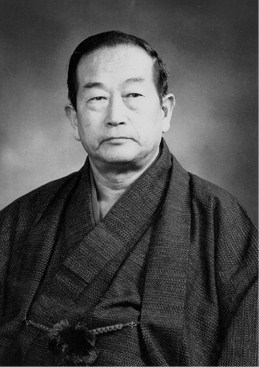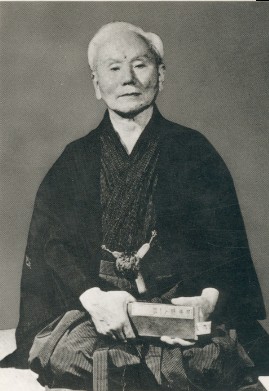[title size=”2″]Shotokan Karate[/title]
Master Gichin Funakoshi is generally regarded as the father of modern Karate. He was born in Okinawa in 1868 and began karate at an early age, under the instruction of Master Itosu. At a later date he also studied under Master Azato. These were the two men who were responsible for the shaping of his karate, developing his expertise, and highly disciplined mind.
Funakoshi went on to become a school teacher but he still continued with his karate. But It was in 1922 that he was asked to give a martial arts demonstration of his Karate, at the ‘Women’s Higher Normal School’ in Tokyo. Here Master Funakoshi had his chance to introduce the Okinawan art of karate to the Japanese mainland. The demonstration was a huge success, and led to a strong friendship between Master Funakoshi and Jigorō Kanō, the founder of Judo.
The martial arts world in Japan, especially from the early 20’s and up to the early 40’s, was an ultra-nationalist moment in history, and they looked down their nose at any art that was not pure, calling it a pagan and savage art. Funakoshi overcame these prejudices and finally gained formal recognition of Karate as one of the Japanese martial arts by 1941.
Master Funakoshi decided to move to Japan to teach karate on a full time basis In 1932. Their, Masatoshi Nakayama began his karate training under Master Funakoshi at Takushoku University in Tokyo and later, under his son Yoshitaka. It was in 1949 that Masatoshi Nakayama formed the ‘Japan Karate Association’ with Master Funakoshi as it’s chief instructor. Together Master Funakoshi and Master Nakayama created the infamous JKA instructors class. From this class came the Japanese Sensei’ that we are now very familiar with; Sensei Hirokazu Kanazawa, Sensei Keinosuke Enoeda, Sensei Taiji Kase and Sensei Hiroshi Shirai to name but a few. It was later that Master Nakayama established karate competitions and took on the task to spread karate throughout the world, and these instructors, along with others, were instrumental in making this happen. Gichin Funakoshi also wrote several books including: Karate Dō Kyohan, Karate Dō Nyūmon and Karate Dō – My Way of Life.
Funakoshi practiced calligraphy and signed his work, “Shoto”, meaning “pine waves”, this was Funakoshi’s pen-name, which he used in his poetic and philosophical writings and messages to his students. The Japanese word “kan” means “house” or “hall”. In honour of their sensei, Funakoshi’s students created a sign reading shōtō-kan which was placed above the entrance of the hall where Funakoshi taught. Hence, the school where he taught came to be known as Shoto’ school. Today, his style of karate is one of the major karate systems practised throughout the world. Gichin Funakoshi never gave his style a name, just simply calling it “karate”. He died in 1957 aged 89, after humbly making the largest contribution to the art of Karate-do.
Shotokan is one of the most popular styles of karate systems in the world, and is influenced directly by the Okinawa style of Shuri-te, it is characterised by powerful linear movements and deep, strong stances . Karate literally means, ”way of the empty hand”, and contrary to its image is a non aggressive sport and pastime which can be enjoyed by anyone. Although a fighting system it is the blocks you will learn first, closely followed by punching and kicking techniques. Karate is not only a physical pastime but also promotes discipline and control resulting in peace of mind and self confidence, and of course life skills that can assist in keeping yourself and your loved ones safe.
We are proud members of The Traditional Shotokan Karate Association, formed by Sensei Peter Manning 7th dan. The association prides itself in maintaining high standards of traditional Karate in the UK. With over six hundred students training in our nationwide family of clubs, we have a proven track record in quality teaching and traditional values, we also host regular training seminars, and a annual residential course, where we have a whole weekend of hard training, often including the sea, as well as a fantastic social aspect to these events.
Shotokan Karate training is divided into three main areas: kihon (basics), kata (forms or patterns of moves), and kumite (sparring). Techniques in kihon and kata are characterized by deep, long stances that provide stability, enable powerful movements, and strengthen the legs. Shotokan is often regarded as a ‘hard’ and ‘external’ martial art because it is taught that way to beginners and coloured belts to develop strong basic techniques and stances. Initially strength and power are demonstrated instead of slower, more flowing motions. Those who progress to brown and black belt level develop a much more fluid style which incorporates grappling and some aikido-like techniques, which can be found in the black belt katas. Kumite techniques mirror these stances and movements at a basic level, but progress to being more flexible and fluid like with greater experience and time.
Sensei Chris Syrett 3rd Dan

